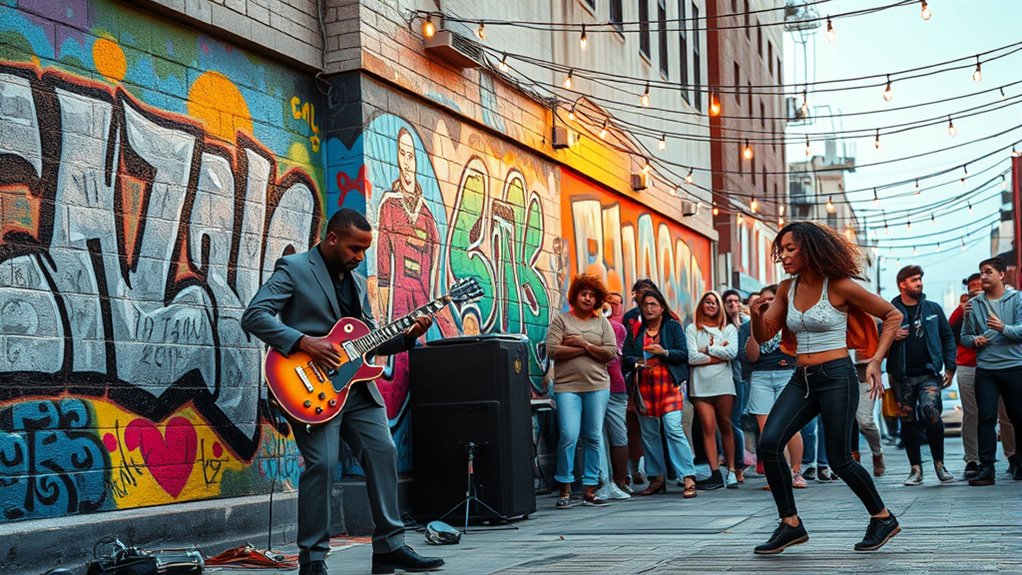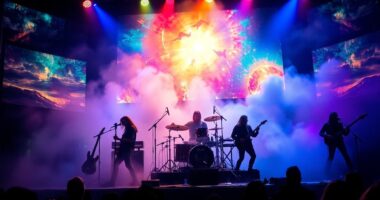If you’re curious about artists who blend genres seamlessly, you’ll find plenty of innovators like Anderson .Paak, who combines jazz, hip-hop, and R&B, or Flying Lotus, known for mixing electronic, experimental, and jazz sounds. Artists like Bonobo and Thundercat push genre boundaries to create fresh, enthralling music that defies traditional labels. Exploring their work shows how genre fusion can challenge norms and inspire. Keep exploring to discover more artists redefining musical boundaries in exciting ways.
Key Takeaways
- Many artists experiment with blending genres like jazz, hip-hop, rock, and electronic to create innovative and unique sounds.
- Artists such as Anderson .Paak and Frank Ocean seamlessly combine R&B, soul, and hip-hop influences in their music.
- Bands like Gorillaz fuse alternative rock, electronic, and hip-hop elements for a diverse auditory experience.
- Musicians like Björk and St. Vincent incorporate various genres, showcasing experimental approaches to genre fusion.
- Genre-blending artists often push creative boundaries, inspiring others and evolving the musical landscape.

Many artists today stand out by blending genres seamlessly, creating fresh sounds that defy traditional boundaries. When you listen to their music, you realize that the fusion of styles isn’t just about mixing different sounds; it’s about pushing the envelope of what music can be. These artists don’t stick to one genre—they experiment boldly, blending elements from various musical traditions to craft something uniquely their own. This genre experimentation allows them to break free from conventional molds, offering listeners a new auditory experience that surprises and excites.
You might find yourself captivated by how effortlessly they combine genres. For example, an artist might merge rock with electronic dance music, resulting in high-energy tracks that feel both familiar and innovative. Or they could fuse jazz with hip-hop, creating complex melodies layered with rhythmic vocal flows. This fusion of styles isn’t accidental—it’s a deliberate effort to challenge norms and expand the boundaries of musical expression. It’s about creating a sound that’s not confined by any single tradition but instead celebrates the richness of multiple influences.
Artists blend genres like jazz and hip-hop to challenge norms and expand musical boundaries.
By blending genres, these artists also open up new avenues for storytelling. They can evoke different emotions by drawing from diverse musical vocabularies, making their work more relatable and multidimensional. When you experience this kind of genre experimentation, you’re invited into a world where music knows no limits. It encourages you to explore unfamiliar sounds, to discover new favorites, and to appreciate the artistry that comes from blending seemingly disparate elements into a cohesive whole.
Many of these trailblazing musicians don’t shy away from taking risks. They understand that genre experimentation can be polarizing but see it as an essential part of artistic growth. Their willingness to defy expectations inspires other musicians to push boundaries themselves. This constant evolution keeps the music landscape vibrant and unpredictable, giving you a reason to keep listening, discovering, and redefining what music can be.
Ultimately, the fusion of styles and genre experimentation aren’t just trends—they’re crucial tools for artists seeking authenticity and innovation. When you tune into their work, you’re witnessing the evolution of music itself. These artists challenge the status quo and prove that blending genres seamlessly isn’t just a craft, but a powerful form of creative expression.
Additionally, embracing genre experimentation enables artists to tap into a broader range of influences, enriching their creative palette and connecting with diverse audiences.
Frequently Asked Questions
How Do Genre-Blending Artists Influence Mainstream Music Trends?
Genre-blending artists influence mainstream music trends by driving cultural crossover and encouraging stylistic experimentation. You notice how their innovative sounds inspire other musicians to push boundaries, creating fresh, diverse playlists. Their willingness to combine different genres sparks audience curiosity and broadens musical tastes. As a result, mainstream music evolves, embracing more eclectic styles, making it more dynamic and inclusive, ultimately shaping the future landscape of popular music.
What Are the Challenges Artists Face When Combining Diverse Genres?
You might think blending genres is easy, but cultural barriers and maintaining your artistic identity pose real challenges. You need to navigate differing musical traditions and audience expectations, risking alienating fans or diluting your style. Staying true to your vision requires resilience, as you balance innovation with authenticity. Overcoming these hurdles pushes you to creatively fuse sounds while respecting diverse influences, ultimately enriching your artistic expression without compromising your core identity.
How Do Fans Typically Respond to Genre Fusion in Music?
You might find that fans are often intrigued and excited by genre fusion, as it offers fresh sounds and surprises. However, some listeners have strong audience expectations and prefer genre purity, risking disapproval if the blend feels uneven or unfamiliar. Overall, many appreciate creativity and originality, but success depends on how well you balance those expectations with innovative musical experimentation.
Are There Specific Genres More Commonly Blended Than Others?
You’ll notice that pop and hip-hop are the most commonly blended genres, capturing around 40% of such collaborations. This popularity stems from cultural influences, like hip-hop’s roots in storytelling and pop’s universal appeal. Genre fusion thrives when artists push boundaries, making music more diverse and exciting. So, if you love innovative sounds, these genres are where you’ll see the most exciting crossovers, reflecting evolving tastes and cultural exchanges.
How Has Technology Impacted Genre Fusion in Recent Years?
Technology has drastically impacted genre fusion by enabling digital production and virtual collaboration. You can now experiment with diverse sounds and styles easily, blending genres in ways that weren’t possible before. Digital tools give you access to a vast array of samples and effects, while virtual collaboration connects you with artists worldwide, fostering innovative genre mashups. This integration pushes creative boundaries, making genre blending more dynamic and accessible than ever.
Conclusion
So, next time you hear a track that feels like a musical mosaic, remember these artists who blur genre lines effortlessly. They’re like DJs spinning vinyl in a neon-lit club of sound, where anything goes. Their creativity proves that music’s true magic lies in its fluidity—think of it as the original mash-up, a timeless remix of styles. Embrace the unexpected and let your playlist become a vibrant tapestry of genres.








